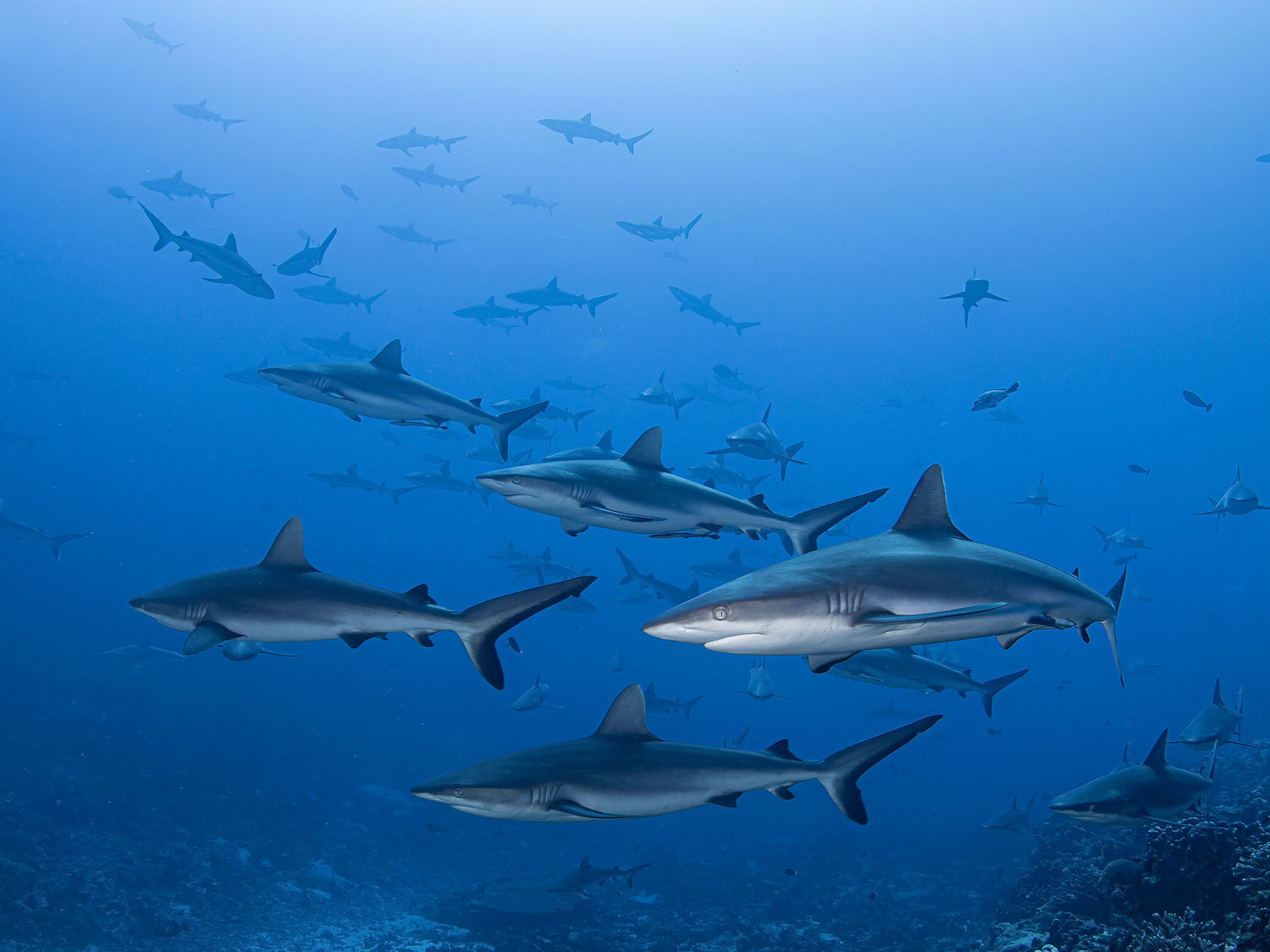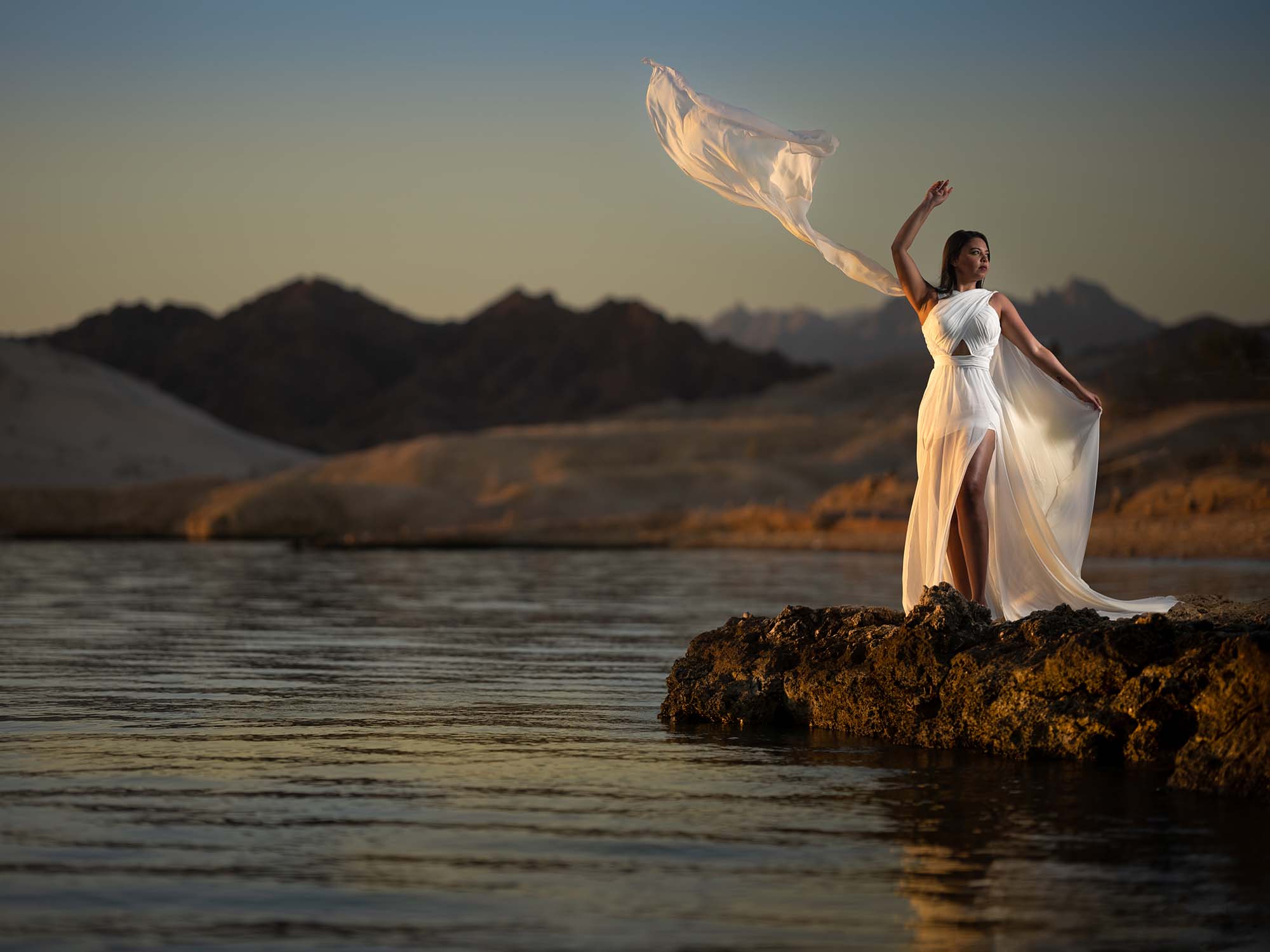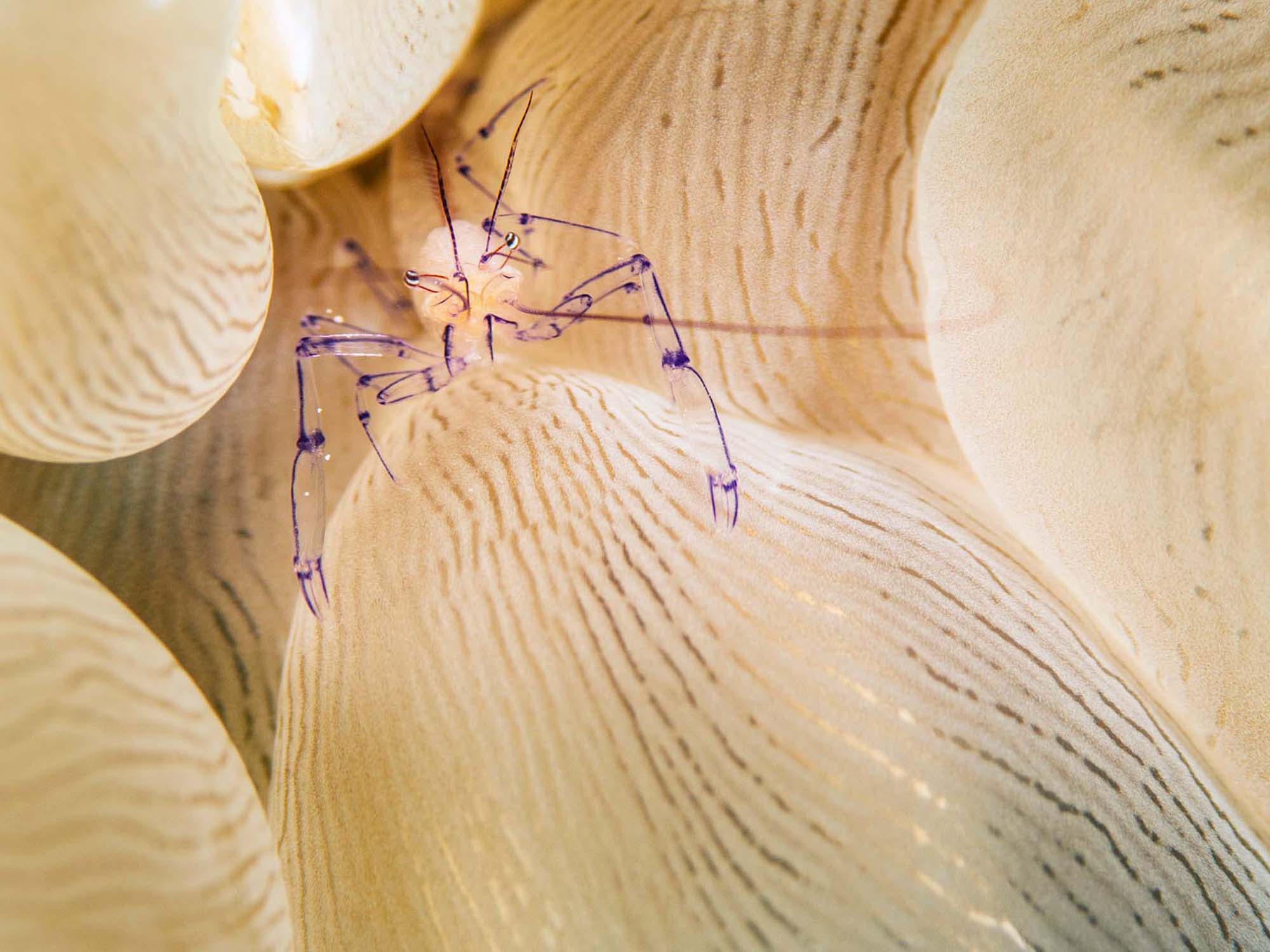By Douglas Klug
All photos © 2024 Douglas Klug
Every diver has trips they go on just to dive, but most divers also have that list of “once in a lifetime” trips. For underwater photographers, these “list” trips usually include specific encounters they hope to capture with an image. 2023 presented the opportunity for my primary dive buddy (my wife) and I to cross one of those trips off our own list. I did my research about the images I wanted and realized the trip had such a broad range of diving that the equipment and lighting needs would change from one stop to the next. At each location, control of the cameras lighting systems would be crucial to capturing the right images.
Here’s how I put it together, what gear I used to do it, and some of the work I brought home.
The Itinerary
French Polynesia spans 121 islands and atolls stretching across the South Pacific Ocean. This itinerary stopped at four locations chosen for their unique underwater photographic opportunities:
- Turtles in Tahiti
- Dolphins in Rangiroa Atoll
- Wall of Sharks in Fakarava Atoll
- Macro in Moorea
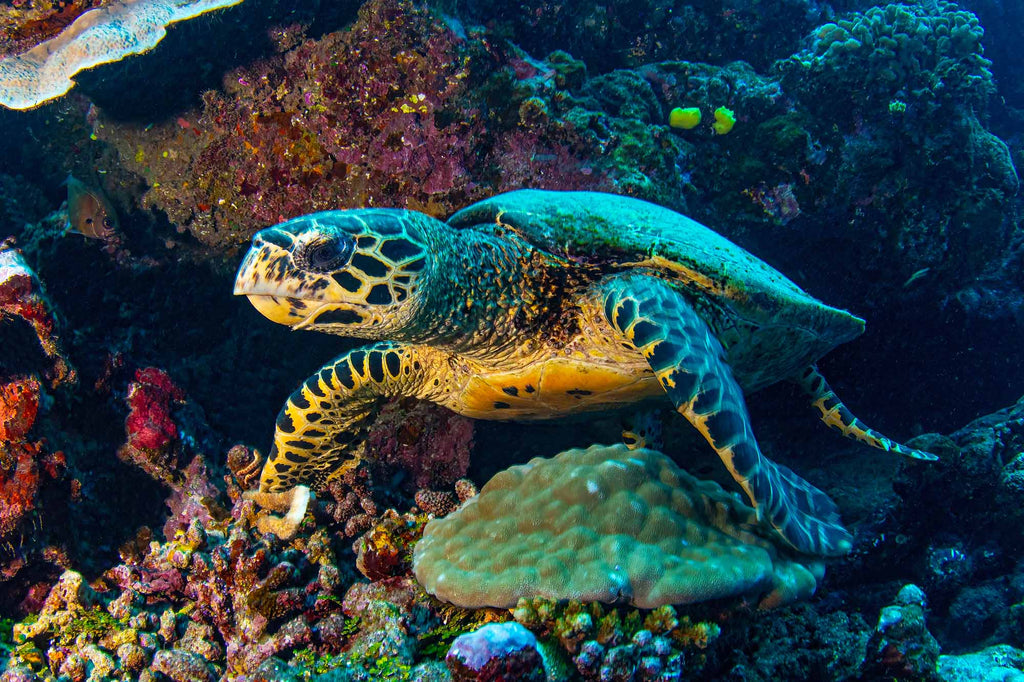
Hawksbill Turtle on a Tahitian Reef • Tokina 10-17mm with Compact 8" Dome • f/9 • 1/100 • ISO 400
The Gear
With different subjects on different islands, I knew I’d be shooting in a variety of environments and had to bring everythign I needed for each area.
Camera: Canon Rebel T8i (850D) in the Ikelite 200DL Underwater Housing
Wide Angle Lens: Tokina 10-17mm Fisheye with DL 8" Dome Port and DL Compact 8" Dome Port
Macro Lens: Canon EF 60mm f/2.8 Macro with DL Flat Port
Lighting: Dual Ikelite DS161 Strobes w/ diffusers, DL5 DS Link TTL Converter, Light & Motion Sola 1200 Photo focus light
Camera Settings: (M) Manual control over shutter speed and aperture with Auto ISO set to max 800; TTL strobe exposure
Tahiti
Tahiti has rich hard-coral reefs and a large population of both green and hawksbill sea turtles. On Tahiti, my hope was to spend some warm-up dives capturing some quality reef scenes that showed off the islands turtle population.
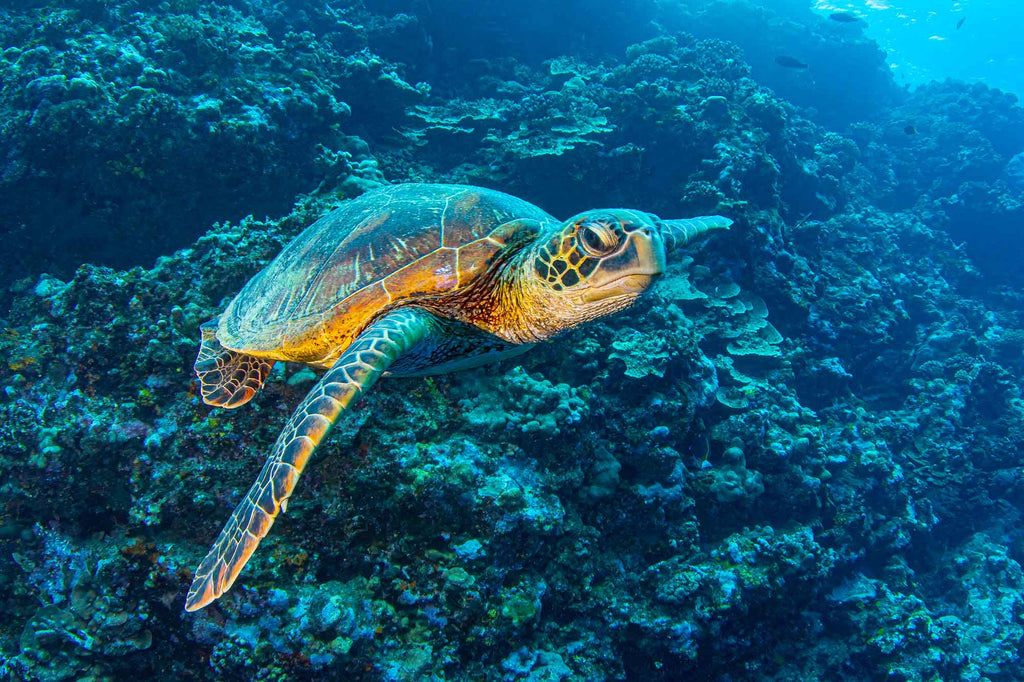
Green Sea Turtle over a Tahitian Reef • Tokina 10-17mm with Compact 8" Dome Port • f/9 • 1/100 • ISO 400
Tahiti’s hard coral reefs support a healthy population of sea turtles. It didn’t take long to find them, though on the outside walls of the island’s barrier reefs, the turtles were resting at about 60-70 feet (20-23 meters).
Good lighting control is crucial to capture the colors at these depths, and just bringing strobes along isn’t enough. For these shots, I slowed down the shutter speed to allow more natural light into the camera while raising the f/stop just a bit to keep more of the image in focus. I got as close as I could to the turtles, making them my point of focus which in turn told the TTL to push out only enough light to fill in the foreground. This technique brings out the color of the subject nicely, allows for natural light to fill the background, and has the added advantage of not “blasting” the turtles with so much light that they become uncomfortable and leave.
Rangiroa Atoll
Rangiroa Atoll has a resident pod of wild bottlenose dolphins known to seek out and interact with divers. None of the operators here chase, bait, or otherwise entice the dolphins so the interactions at Rangiroa Atoll are on the animal’s terms. From Rangiroa Atoll, I hoped to bring home images of dolphins that captured their intelligence and willingness to interact with divers.

Bottlenose Dolphins on the deeper part of the reef outside the Tiputa Pass • Tokina 10-17mm with Compact 8" Dome Port • f/9 • 1/160 • ISO 800

Tokina 10-17mm with Compact 8" Dome Port • f/9 • 1/125 • ISO 200
The diving at Rangiroa Atoll is just outside the Tiputa Pass, on the “open ocean” side of the atoll where the barrier reef becomes a wall into deep water. The dolphins made their appearances regularly, visiting divers as deep as 90 feet (30 meters) but also just below the surface. The changes in lighting from the surface to 90 feet (30 meters) created the need for adjusting shutter speeds and strobe output based on ambient lighting.
Fast moving subjects like dolphins require a faster shutter speed and a higher f/stop in order to keep them in focus, so the TTL was a must to provide just enough flash to light them without bothering them or overexposing the background. In addition to the dolphins, the shallow areas of the reef outside the Tiputa Pass were teeming with life and provided some other photographic opportunities where a slower shutter speed, higher f/stop, and TTL lighting captured nice color on the subject without washing out the background.

Racoon butterflyfish school among clouds of reef fish outside the Tiputa Pass • Tokina 10-17mm with Compact 8" Dome Port • f/9 • 1/100 • ISO 320
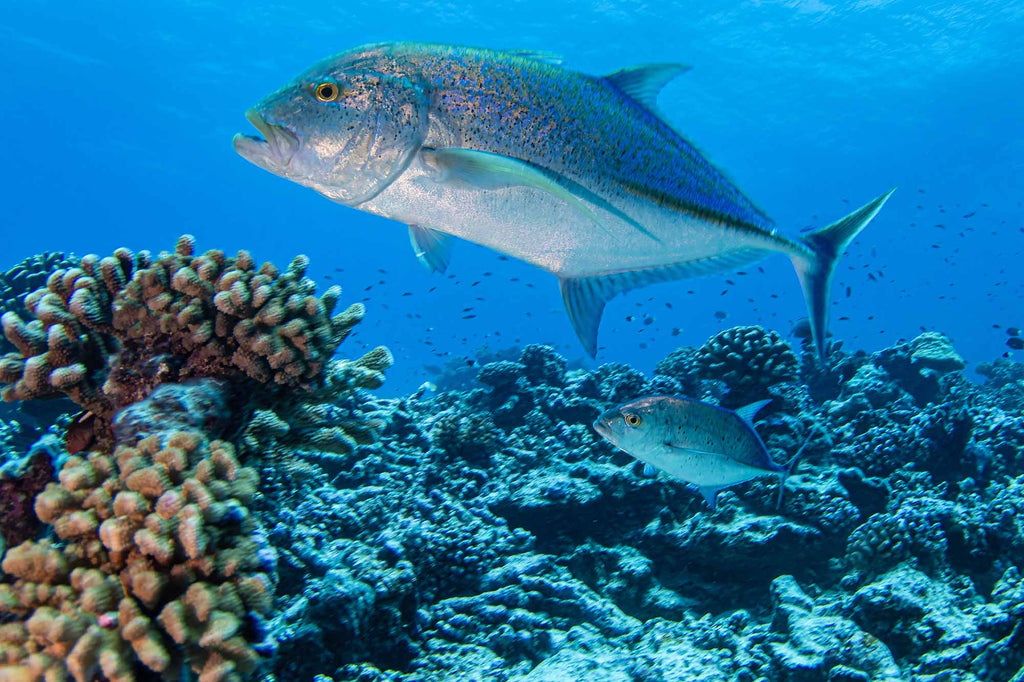
Giant Trevally pair on the shallow reefs outside the Tiputa Pass • Tokina 10-17mm with Compact 8" Dome Port • f/8 • 1/160 • ISO 400
Fakarava Atoll
Fakarava Atoll is so remote and untouched it’s been identified as a UNESCO world heritage site. The area known as the south pass at Fakarava Atoll is home to what’s known as the “wall of sharks” where hundreds of grey reef sharks gather in the current daily. Fakarava Atoll has more to offer than just the magnificent schooling grey reef sharks. The strong currents feed a healthy hard coral reef that is teeming with life as it comes within inches of the surface. Dozens of resident blacktip sharks swim lazily in knee-deep water right over the top of shallow sunlit coral beds. From Fakarava Atoll I wanted images that captured the essence of the “wall of sharks,” but also wanted to show off the islands shallow coral beds and ever present black-tip sharks with a classic “split shot”.
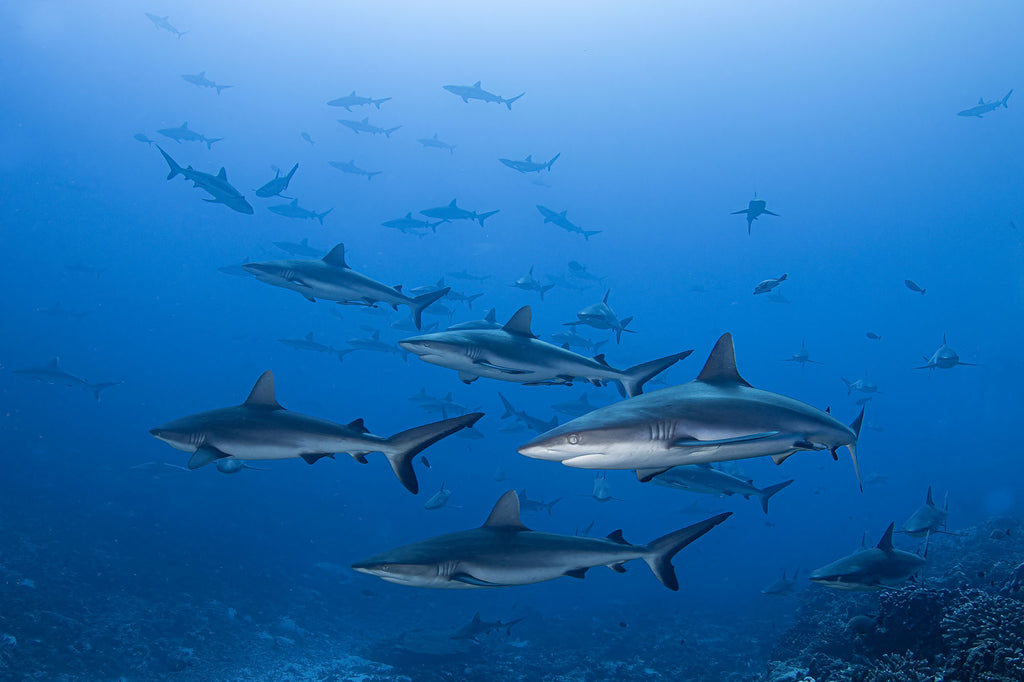
Gray reef sharks schooling in the depths of Fakarava Atoll's south pass. Looking off into the distance, I count over 50 sharks in this image. • Tokina 10-17mm with Compact 8" Dome Port • f/10 • 1/80 • ISO 250

A Blacktip Reef Shark over the shallow sunlit reef at Fakarava Atoll • Tokina 10-17mm with Compact 8" Dome Port • f/13 • 1/200 • ISO 800
The south pass at this tiny, remote atoll presented some of the biggest challenges to capture the images I wanted. The action for the famed “wall of sharks” was close to 100 feet (33 meters) deep where ambient light was less than at surface. Slow shutter speeds and mid-range f/stop allowed more light to reach the camera while letting the camera see the true depth of the sharks out into the distance. By focusing on the closest sharks, the TTL powered the strobes just enough to “freeze” those sharks in crisp motion without washing out the sharks in the distance.
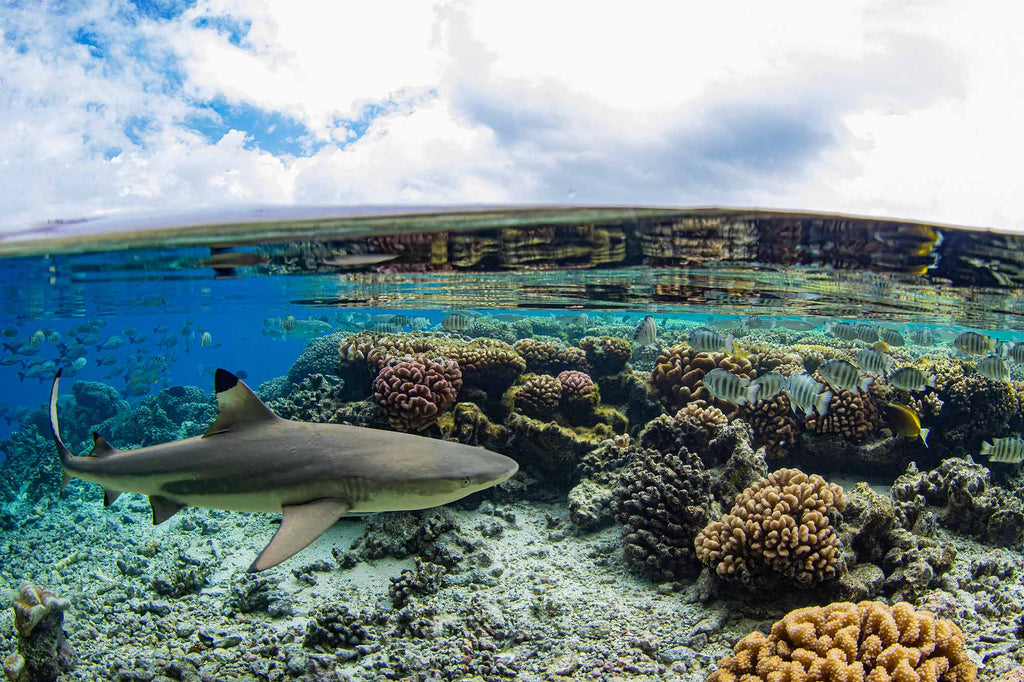
Sunny skies with tropical clouds, shallow reefs, and a Blacktip Reef Shark. • Tokina 10-17mm with full size DL 8" Dome Port • f/13 • 1/160 • ISO 640
I found different challenges working with the blacktip sharks at depths sometimes less than 3 feet (1 meters) while the intense tropical sun shined down from overhead and bright colored corals reflected its light. To avoid having the intense ambient sunlight wash out my shots, I raised the shutter speed and aperture, then let the TTL power up the strobes to fill in any shadows created.
Finally, I set out to capture the Fakarava Atoll “signature” split-shot with blue-skies, coral reefs, and one of the beautiful blacktip sharks. To capture the image, I used the old adage “meter over / focus under,” with the shutter speed and aperture setting based on the sunlight but focus point below the surface. For ease of movement, I created this shot without the use of strobes.
Moorea
Moorea is a heart-shaped island just a 30-minute boat ride from the island of Tahiti. It boasts healthy hard coral reefs that are home to giant anemones with colonies of colorful anemone fish and pipefish. In the fall, the Antarctic group of Humpback Whales come to the island’s calm reefs so mothers can bear and feed their calves before they head back to their frigid feeding waters. With sunny skies and clear waters, I hoped that Moorea would allow me to capture images of the colorful anemone fish and pipefish, as well as the encounters with the humpback whales.
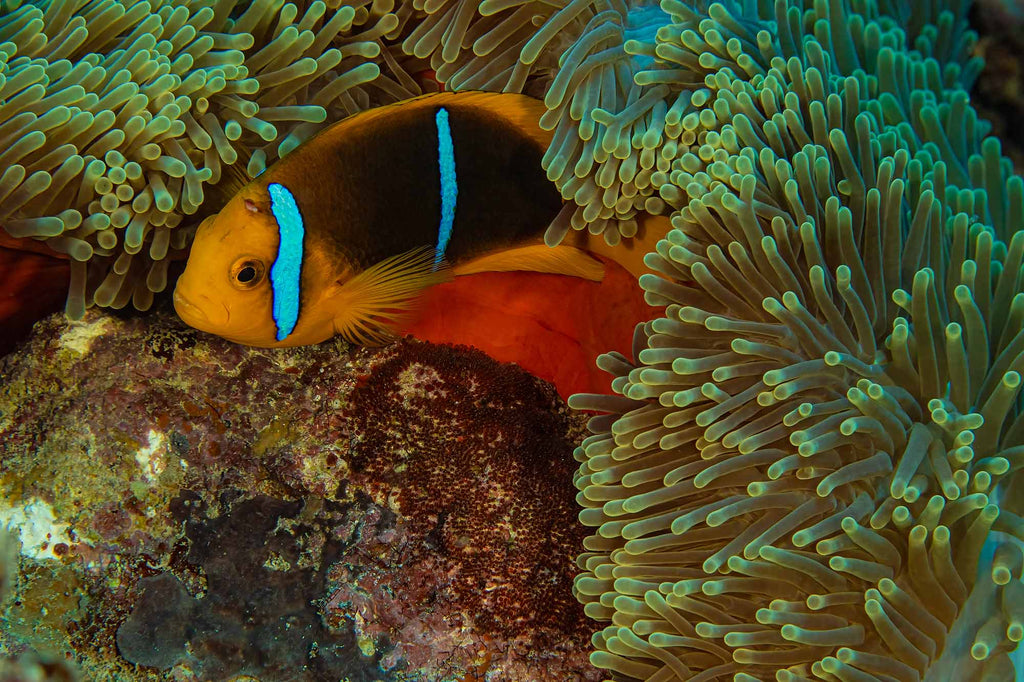
An Orange Fin Anenomefish guarding eggs laid on the rock substrate adjacent to the anemone where it lives. • Canon 60mm Macro • f/9 • 1/160 • ISO 800
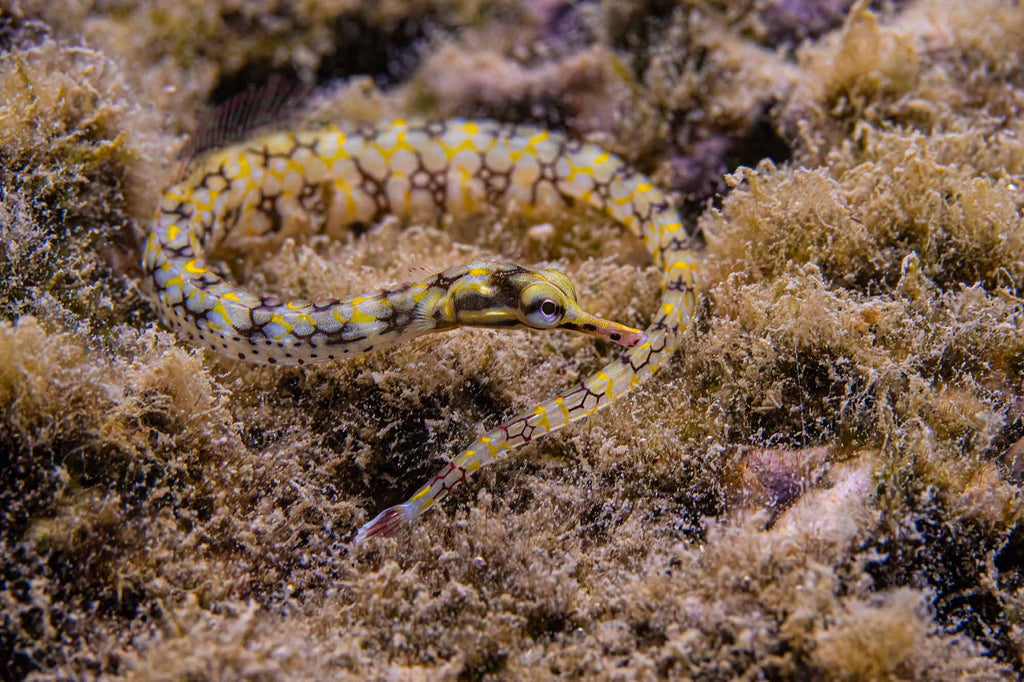
Pipefish atop a reef. • Canon 60mm Macro • f/9 • 1/250 • ISO 800
The anemone fish and pipefish found in the shallows around this island both tend to like areas with water motion. Shooting in the surge is challenging and requires faster shutter speeds and higher apertures to ensure the subject is captured in focus. For the anemone fish, I used strobes to bring out the colors and freeze motion. The pipefish, however, were at the very tops of the reef and too shallow to maneuver strobes, so I shot them with only the natural sunlight, making the necessary changes to shutter speed and aperture to avoid having the intense sun wash out the image.
Moorea’s humpback whales were a different story. They are far too fast and mobile to try swimming with strobes, so I found it better to wait until they were at the sunny surface and then shoot images with natural light. The speed at which the shots presented themselves, combined with the intense sunlight at the surface and their overall size, had me shooting at higher shutter speeds and apertures from a distance that kept as much of the scene as possible sharp and in focus.
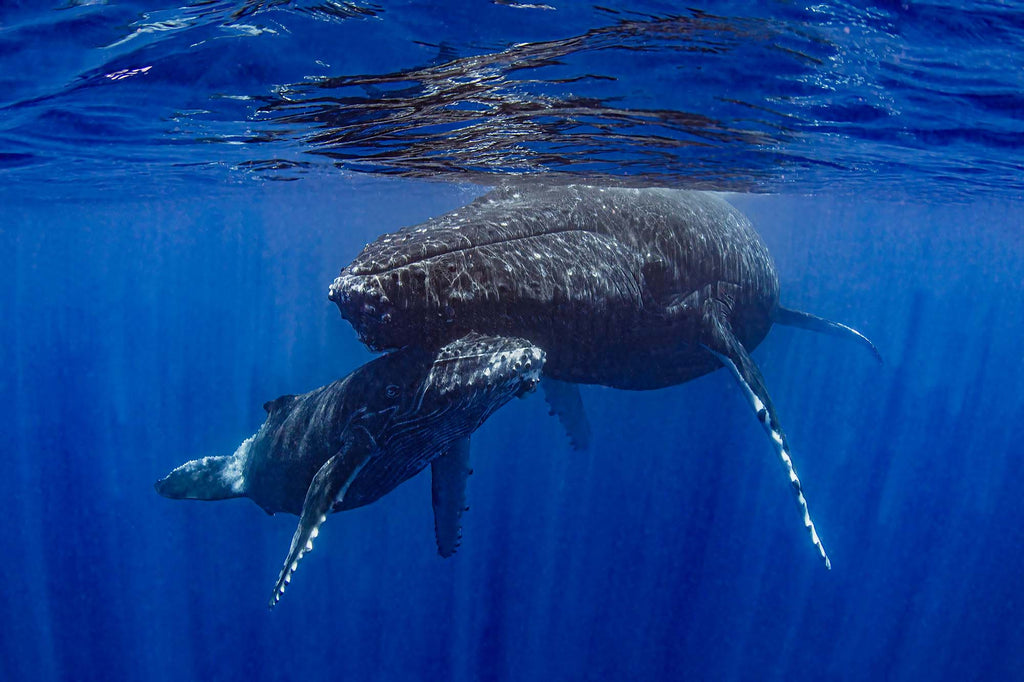
This Humpback Whale calf and mother were clearly bonded and the calf, though curious about us, stayed close to its mother. • Tokina 10-17mm with full size DL 8" Dome Port • f/11 • 1/160 • ISO 640

After spending some time allowing them to get used to us, the calf's curiosity was too strong and it left mom to approach us. • Tokina 10-17mm with full size DL 8" Dome Port • f/8 • 1/200 • ISO 500
Additional Reading
Gray Whales, Blue Water | Photographing Humpback Whales in Moorea
Customer Photos | Douglas Klug in California's Kelp Forests and Beyond
My Top 5 Favorite Wrecks of Truk Lagoon
An Insider's Guide to Diving Yap, Micronesia
Planning a Trip to Tonga to Swim with Humpback Whales
Diving Bikini Atoll and the Legacy of US Nuclear Testing [VIDEO]
An Insiders Guide to Diving Wakatobi Resort Indonesia

Douglas Klug has been diving California’s Channel Islands for over 30 years as a SCUBA diving instructor and underwater photographer in Santa Barbara, CA. Doug specializes in underwater photography within the kelp forest environment. His photo-essays have been published in print world-wide, including articles in California Diving News, DAN Alert Diver, and Dive Training. Doug’s images have been used in many publications and by the US National Park Service, US National Marine Sanctuary, the Monterey Bay Aquarium, Google, and Microsoft. Doug even does live talks on underwater photography for dive clubs and museums in Southern California. See more...











